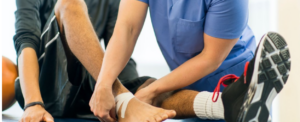
7 Ways To Help Prevent Injuries in Youth Athletes
By Erin Bennett, President of Ludis Athletics
7 ways to help prevent injuries in youth athletes. Youth sports offer numerous lifelong health benefits, including improved socialization skills, discipline, and the cultivation of healthy exercise habits.
However, it is disheartening to note that a staggering 3.5 million sports-related injuries afflict children in the United States every year, with 50% of these injuries being preventable, as reported by the CDC (Heads Up to Youth Sports, 2019).
The importance of injury prevention strategies for youth athletes cannot be overstated. Safeguarding their well-being on and off the field is crucial. By implementing effective preventive measures, we can ensure that young athletes thrive in a safe and nurturing environment while reaping the countless benefits of participating in sports.
The following tips will help keep your young athlete in the game:
1) Get an Injury Prevention Screen
An injury prevention screen can ensure that your athlete is well-prepared for the season. While many athletes undergo a preseason physical, an injury prevention screen can be conducted at any time of the year.
By assessing factors such as gait, jumping ability, and strength, a Doctor of Physical Therapy can identify potential risk factors and develop a personalized injury prevention training program. They can identify areas of weakness and imbalance from overuse, compensations from past injuries, or simply an athlete’s normal way of doing things that might be throwing off their bodies.
Research has shown that participation in injury prevention programs can lead to a significant 53% reduction in ACL injury rates. In fact, a meta-analysis encompassing eight studies and a total of 13,562 participants supports these findings (Arundale et al., 2023).
By prioritizing an injury prevention screen, you can take proactive steps to minimize the risk of injuries and keep your young athlete in the game.
2) Sleep, Sleep, and More Sleep
Ensuring an adequate amount of sleep is vital for young athletes. On average, they should aim for 9 hours of sleep, while elite athletes can benefit from up to 10 hours of sleep.
And in a study done by Matthew Milewski, MD, of the Children’s Orthopaedic Center, Children’s Hospital of Los Angeles, they found that Athletes who sleep on average less than 8 hours per night experience 68% more sports injuries than students who sleep for eight or more hours. Sleep is all about repair, both mental and physical. The quality and the amount of sleep, to a great extent, determine the effectiveness of recovery. Simply put, when an athlete doesn’t get enough sleep, they are more prone to injury and illness.
Inadequate sleep can lead to compromised attention and delayed reaction times, negatively impacting not only their athletic performance but also their academic achievements.
It is crucial to create a sleep-friendly environment for youth, such as a dark and quiet room, and establish a routine that includes eliminating screen time for at least 30 minutes before bed.
Ideally, phones and tablets should be turned off and kept in separate rooms to minimize distractions and promote better sleep quality.
3) Emphasize Warm Up and Cool Down
Giving due importance to both warm-up and cool-down routines is crucial for young athletes.
Warm Up
A dynamic warm-up program, lasting approximately 15 minutes, should be performed to prepare the body for the demands ahead. It should include exercises that target all major muscle groups, with stretches held for no more than a few seconds.
The primary goal of the warm-up is to increase the heart rate, improve blood flow, and prime the muscles and joints for optimal performance. Examples include:
- High knees
- Butt kicks
- Hip openers
- Leg swings
By incorporating a comprehensive warm-up routine, young athletes can enhance their readiness and reduce the risk of injuries.
Cool Down
Equally important to the warm-up is a proper cool-down routine after a workout or game. The cool-down phase allows the body to gradually transition from intense activity to a resting state, promoting recovery and reducing muscle soreness.
One effective method is static stretching, where stretches are held for longer durations, typically around a minute each. Static stretching helps to lower the heart rate, breathing rate, and body temperature. Examples include:
- Triceps stretch
- Quadriceps stretch
- Hip flexors stretch
By incorporating these static stretches, young athletes can improve their recovery and prepare their bodies for future events.
Implementing a structured cool-down routine is essential for promoting overall well-being and long-term athletic success.
4) Get the Proper Equipment
Having the right equipment is crucial for young athletes, as it not only enhances performance but also reduces the risk of injuries.
Protective gear, such as proper shoes and guards, should be prioritized. Ill-fitting shoes can significantly impact running and jumping mechanics, potentially leading to injuries in the feet, ankles, knees, hips, and lower back.
It is important to note that children experience rapid growth, and their shoe or helmet sizes can change within a single season. Therefore, it is essential to check for a proper fit and make necessary adjustments consistently.
By ensuring that young athletes have the appropriate equipment, we can promote their safety, optimize their performance, and mitigate the risk of injuries.
5) Emphasize Proper Movement Mechanisms
Ensuring proper movement mechanics in sports is crucial for coaches and parents to reduce the risk of injuries. By teaching and reinforcing correct techniques, we can decrease the likelihood of accidents and their associated consequences.
For example, in football, there is a proper way to tackle that helps reduce the occurrence of concussions. Similarly, in volleyball, emphasizing the appropriate technique for jumping and landing can help minimize the risk of ACL tears.
While external factors like colliding with another player may sometimes lead to unavoidable injuries, training young athletes with proper mechanics can significantly improve their outcomes.
By prioritizing and consistently reinforcing proper movement mechanics, we can promote the safety and well-being of our young athletes in their chosen sports.
6) Recognize Injury and Intervene Immediately!
Recognizing and promptly addressing injuries is crucial for young athletes as it can significantly impact their recovery process.
Unfortunately, there is often pressure from players, parents, and coaches to push through pain, especially during important games or tournaments. However, playing through an injury can exacerbate the condition, potentially leading to more severe damage and the need for surgical intervention, ultimately prolonging the recovery period.
It is essential to prioritize the long-term well-being of young athletes by promptly recognizing signs of injury and intervening immediately. By seeking appropriate medical attention and implementing the necessary interventions, we can ensure a faster and more effective recovery, allowing the athlete to return to their sport in a safe and healthy manner.
7) Know When to Consult Your Sports Physician
Knowing when to consult your sports physician is essential for the well-being of young athletes. Keep an eye out for the following signs and symptoms that warrant medical attention:
- Consistent pain during or after sports activities
- Persistent or new swelling around a joint
- Heat or redness around an area of pain that does not subside after cooling down
- Joints ‘giving way’ or feeling unstable
- Painful popping and snapping sensations
- Pain that does not improve with rest
- Describing a sensation of something ‘popping out of place’
If any of these symptoms occur, it is important to seek the expertise of a sports physician to ensure proper diagnosis, treatment, and prevention of further complications.

References: Arundale, A. J. H., Bizzini, M., Dix, C., Giordano, A., Kelly, R., Logerstedt, D. S., Mandelbaum, B., Scalzitti, D. A., Silvers-Granelli, H., & Snyder-Mackler, L. (2023). Exercise-based knee and Anterior Cruciate Ligament Injury Prevention. Journal of Orthopaedic & Sports Physical Therapy, 53(1). https://doi.org/10.2519/jospt.2023.0301 Centers for Disease Control and Prevention. (2019, March 5). Heads up to youth sports. Centers for Disease Control and Prevention. https://www.cdc.gov/headsup/youthsports/index.html
More great articles like this one:
How To Survive Your Kid’s Game-Time Sports Injuries














